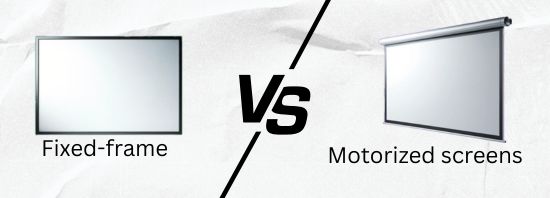Choosing the right projector screen is essential for achieving the best viewing experience. Among the many options available, fixed-frame vs. motorized screens are two of the most popular choices. While both offer excellent performance, they cater to different needs and setups. Understanding their differences can help you make an informed decision based on your budget, space, and viewing preferences.
In this guide, we’ll compare fixed-frame vs. motorized screens, covering their advantages, disadvantages, and the best scenarios for each.
What Is a Fixed-Frame Screen?
A fixed-frame screen is a permanently mounted projector screen with a rigid frame. It is designed for dedicated home theaters and professional spaces where a stable, high-quality image is a priority.
Advantages of Fixed-Frame Screens:
- Superior image quality – Maintains perfect tension with no wrinkles or waves.
- Cinematic experience – Ideal for 4K and high-resolution projections.
- Durability – Made with high-quality materials that last longer.
- No mechanical components – No motors or moving parts reduce the risk of wear and tear.
Disadvantages of Fixed-Frame Screens:
- Permanent installation – Requires a dedicated wall space.
- Less flexible – Not retractable, making it unsuitable for multi-purpose rooms.
- Higher space requirement – Cannot be hidden when not in use.
What Is a Motorized Screen?
A motorized projector screen is a retractable screen that can be rolled up and down using an electric motor. It is ideal for multi-use spaces where flexibility and aesthetics are important.
Advantages of Motorized Screens:
- Space-saving design – Can be hidden when not in use.
- Remote-controlled operation – Adds convenience with automated control.
- Ideal for offices and living rooms – Blends seamlessly into modern interiors.
- Multiple mounting options – Can be ceiling-mounted, wall-mounted, or recessed.
Disadvantages of Motorized Screens:
- Higher cost – More expensive due to motorized components.
- Requires power source – Needs electricity to operate.
- Potential maintenance – Moving parts may require servicing over time.
Key Differences Between Fixed-Frame and Motorized Screens
| Feature | Fixed-Frame Screen | Motorized Screen |
|---|---|---|
| Installation | Permanently mounted | Retractable |
| Image Quality | Excellent with no wrinkles | May have slight tension issues |
| Space Requirement | Requires dedicated space | Space-saving design |
| Cost | More affordable | Typically more expensive |
| Convenience | Always ready to use | Needs setup before viewing |
| Ideal For | Home theaters, conference rooms | Multi-purpose rooms, offices |
Which One Should You Choose?
The choice between fixed-frame vs. motorized screens depends on your needs:
- Choose a fixed-frame screen if you have a dedicated home theater and want the best image quality.
- Opt for a motorized screen if you need a flexible setup in a shared space where the screen can be retracted when not in use.
Conclusion
Both fixed-frame vs. motorized screens offer unique advantages, but your decision should be based on your available space, usage needs, and budget. If you prioritize image quality and permanence, go for a fixed-frame screen. If flexibility and convenience are more important, a motorized screen is the better option.
For the best projector screens at competitive prices, check out our collection of Vision’s projector screens and find the perfect match for your setup!

